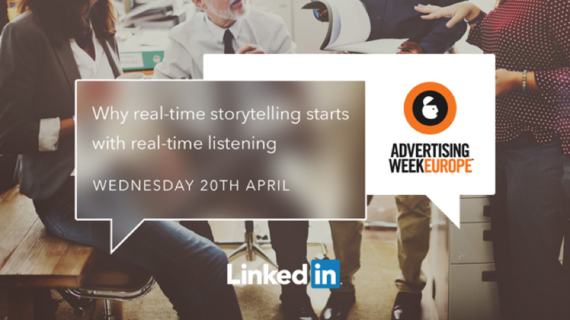Effective brand storytelling is both real-time and responsive
By Keith Richey
Today at Ad Week Europe, I’ll be part of a panel exploring what it means to tell stories in real-time. If you think about that concept for a second, you realise that it’s a fundamentally challenging one. It’s challenging because it calls into question what a story actually is.
To get real-time storytelling right, marketers need to rethink the storytelling process, emphasizing listening first and foremost. Many people, and in particular many marketers, have quite an idealised, romantic concept of the storytelling process. I mean romantic in the sense of troubled Victorian geniuses rather than unfeasibly good-looking characters gazing into each other’s eyes. We imagine great storytellers locking themselves away in ivory towers, or going on long solitary walks in the hills where their imaginations are free to conjure up brilliant, original narratives that the rest of us couldn’t dream of – and which they then relate to their eager audiences. Storytelling feels very much like a one-way process.
That’s also how I believe many marketers have interpreted the concept of brand storytelling. They sit in an office, or a creative studio, and come up with a great, compelling story or series of stories to tell about their brand – then plan how to put those stories out there and engage people with them. It’s a bit like making advertising – but usually with longer copy.
Brand storytelling’s real-time challenge
The problem is, this concept of storytelling hits a big snag when it intersects with the reality of real-time marketing. Because great, enduring narratives that are dreamed up in isolation have a hard time changing and responding to what’s happening out there amongst their audiences. It’s something that open-minded content marketers quickly realise – real storytelling is real-time, responsive storytelling.
At LinkedIn, as on most publishing platforms, the content that audiences engage with is the content that addresses the issues motivating — or challenging — them at that moment. These issues exist on several different levels, of course. They might revolve around the current trending issues in someone’s industry, the immediate priorities for their business, or their own deeper aspirations or goals. They could reside in the head or in the heart – but either way they are of the now. The stories that capture people’s imaginations tend to be the stories they are ready to hear.
This is something that brands with a sense of their own timeless story tend to fall foul of. They might have a great tale to tell – but they often struggle to communicate why people should care about it then and there. Just because they can put their key messages into a narrative with a beginning, middle and end doesn’t make them a storyteller – because storytelling involves something else. That something else is the ability to listen to and interpret the stories already going on in your audiences’ minds: their own narratives, their own priorities. It is by mixing them with your own ideas and using them for inspiration that great storytelling comes about. It’s why we find ourselves engaging with that story as if it’s our own. In a sense, it is.
The secret of great storytelling
History’s great storytellers have almost always had this quality. Think of Homer spinning his tales of Achilles and Odysseus to audiences of aspiring heroes. Then there was Charles Dickens taking aim at the social injustices of Victorian London for an audience who were all-too aware of them. Herman Melville wrote Moby Dick in response to the headlines of his day (the Whaleship Essex being rammed by a whale and sunk) and leveraged the concerns of the crewmates he knew from working on whaleships himself. Great storytellers tend to excel in responding to the stories of others. They have always had a healthy dose of the journalist in them.
Storytelling— accelerated
Real-time storytelling is the opportunity to take this fundamental storytelling process, speed it up, and make it more personalised. It’s an opportunity that comes about because of the real-time (or near real-time) streams of data that inform us what different members of our audience are dealing with, thinking about and responding to.
In the context of LinkedIn, many content marketers use our Trending Content tool to pinpoint the issues that are motivating audiences in different sectors. The best keep a close eye on the engagement rates that different subjects generate when they use them in their Sponsored Content. They take the time to read the comments their updates generate and stay tuned in to what their most engaged audiences are telling them. And they use this real-time radar to figure out how to tell different aspects of their story at that moment.
There’s a balancing act at work here. It’s not a case of wholly rewriting your story to fit in with what people want to hear. Audiences can see straight through such lack of authenticity – and they will quickly become bored if all they’re getting from you is a retread of content they’ve already watched, read or listened to. Great storytellers are original thinkers, the stories they tell have never been told in that way before – and that’s still the secret for brands looking to create great content. They have to bring what’s unique about their brand or business story to the table. It’s in the way they bring this distinct perspective to bear on what their audiences care about that the real craft of storytelling lies.

